Related Research Articles

The Schutzstaffel was a major paramilitary organisation under Adolf Hitler and the Nazi Party in Nazi Germany, and later throughout German-occupied Europe during World War II.

Gottlob Christian Berger was a German senior Nazi official who held the rank of SS-Obergruppenführer und General der Waffen-SS and was the chief of the SS Main Office responsible for Schutzstaffel (SS) recruiting during World War II. At the post-war Nuremberg trials, the Waffen-SS – within which Berger was a senior officer – was declared to be a criminal organisation due to its major involvement in war crimes and crimes against humanity. Berger was convicted as a war criminal and spent six and a half years in prison.
Standartenführer was a Nazi Party (NSDAP) paramilitary rank that was used in several NSDAP organizations, such as the SA, SS, NSKK and the NSFK. First founded as a title in 1925, in 1928 it became one of the first commissioned NSDAP ranks and was bestowed upon those SA and SS officers who commanded a unit known as a Standarte, a unit equivalent to an army battalion and comprising 300–500 personnel.
Reichsführer-SS was a special title and rank that existed between the years of 1925 and 1945 for the commander of the Schutzstaffel (SS). Reichsführer-SS was a title from 1925 to 1933, and from 1934 to 1945 it was the highest rank of the SS. The longest-serving and most noteworthy office holder was Heinrich Himmler.

SS-Oberst-Gruppenführer was the highest commissioned rank in the Schutzstaffel (SS), with the exception of Reichsführer-SS, which became a commissioned rank when held by SS commander Heinrich Himmler. The rank is translated as "highest group leader" and alternatively as "colonel group leader". The rank was correctly spelled Oberst-Gruppenführer to avoid confusion with the more junior rank of Obergruppenführer.

The Allgemeine SS was a major branch of the Schutzstaffel (SS) paramilitary forces of Nazi Germany; it was managed by the SS Main Office (SS-Hauptamt). The Allgemeine SS was officially established in the autumn of 1934 to distinguish its members from the SS-Verfügungstruppe, which later became the Waffen-SS, and the SS-Totenkopfverbände, which were in charge of the Nazi concentration camps and extermination camps. SS formations committed many war crimes against civilians and allied servicemen.
The title of SS and Police Leader designated a senior Nazi Party official who commanded various components of the SS and the German uniformed police (Ordnungspolizei), before and during World War II in the German Reich proper and in the occupied territories.
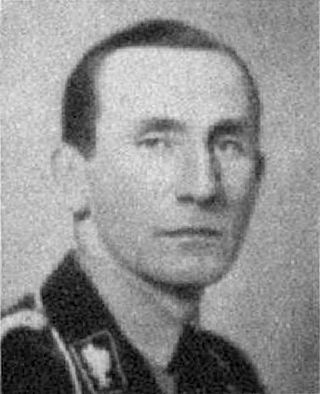
Udo Gustav Wilhelm Egon von Woyrsch was a Nazi Party politician and SS-Obergruppenführer in Nazi Germany who participated in the massacre of Jews in Poland, and was later convicted of being an accessory to manslaughter in connection with the Night of the Long Knives murders.
The SS Main Office was the central command office of the Schutzstaffel (SS) in Nazi Germany until 1940.
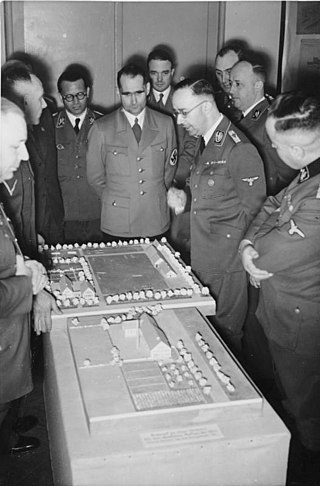
In Nazi Germany the Volksdeutsche Mittelstelle or VoMi was a Nazi Party agency founded to manage the interests of the Volksdeutsche - the population of ethnic Germans living outside the Third Reich. Ultimately coming under Allgemeine-SS administration, it became responsible for orchestrating the implementation of Nazi Lebensraum policies in Eastern Europe during World War II.
Units and commands of the Schutzstaffel were organizational titles used by the SS to describe the many groups, forces, and formations that existed within the SS from its inception in 1923 to the eventual fall of Nazi Germany in 1945.

Ernst-Heinrich Schmauser was a German Nazi Reichstag deputy and SS-Obergruppenführer who was the Higher SS and Police Leader (HSSPF) in Breslau during World War II. He was responsible for the death march from Auschwitz–Birkenau concentration camp, in which upwards of 25 percent of the prisoners were killed. In the last months of the war, he was captured by the Red Army and presumed killed.
Konstantin Kammerhofer was an Austrian Nazi, an SS-Gruppenführer and the Higher SS and Police Leader in the Independent State of Croatia during the Second World War.
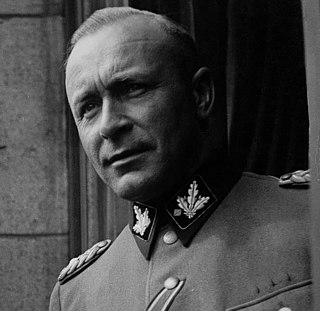
Richard Jungclaus was a German SS-Gruppenführer and Generalleutnant of Police who served as the Higher SS and Police Leader (HSSPF) in Belgium and Northern France. A member of the Waffen-SS, he was killed in combat in the Independent State of Croatia toward the end of the Second World War.
Waldemar Wappenhans was an SS-Gruppenführer and Generalleutnant of police who served as an SS and police leader (SSPF) in the Reichskommissariat Ukraine.

Gerret Korsemann was a German SS-Gruppenführer and Generalleutnant of Police. During the Second World War he served as a police official in the General Government and as an SS and Police Leader in the occupied Soviet Union where he was involved in the Holocaust. At the end of the war, he was convicted of war crimes and imprisoned in Poland.
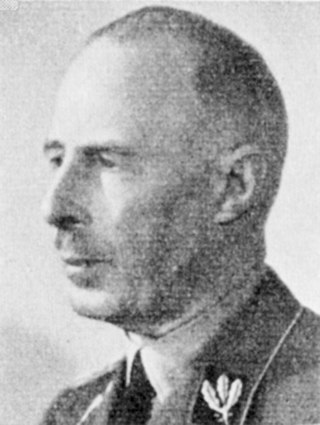
Walter Schmitt was a German SS-Obergruppenführer and General of the Waffen-SS who served as the Chief of the SS Personnel Main Office. He was also a member of the Reichstag from 1943 to 1945. He was executed as a war criminal.

Hans Haltermann was a German engineer, Nazi Party politician and SS officer. As an SS-Gruppenführer and Generalleutnant of Police, he served as an SS and Police Leader in occupied Ukraine and Byelorussia.

Paul Otto Geibel was a German SS-Brigadeführer and Generalmajor of police who served as the last SS and Police Leader (SSPF) "Warsaw" during the Second World War. He was involved in suppressing the Warsaw Uprising and in the subsequent destruction of the city. At the end of the war, he was convicted of war crimes and committed suicide while serving a life sentence in Poland.
Kurt Gustav Ernst Hintze was a Nazi Party politician, SS-Brigadeführer and Generalmajor of police, who served as the last SS and Police Leader (SSPF) in the Generalbezirk Litauen. He was killed in an air raid six months before the end of the war.
References
- Klee, Ernst (2007). Das Personenlexikon zum Dritten Reich. Wer war was vor und nach 1945. Frankfurt-am-Main: Fischer-Taschenbuch-Verlag. ISBN 978-3-596-16048-8.
- Lepage, Jean-Denis G.G. (2014). An Illustrated Dictionary of the Third Reich. McFarland. ISBN 978-1-4766-0369-8.
- Lumsden, Robin (2009). Himmler's SS: Loyal to the Death's Head. History Press. ISBN 978-0-7524-5026-1.
- Steiner, John M. (2013). Power Politics and Social Change in National Socialist Germany: A Process of Escalation into Mass Destruction. Walter de Gruyter. ISBN 978-3-11-080833-9.
- Yerger, Mark C. (1997). Allgemeine-SS: The Commands, Units and Leaders of the General SS. Schiffer Publishing Ltd. ISBN 0-7643-0145-4.